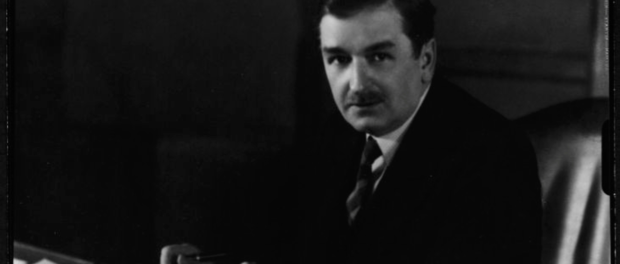1927: The Rise of Duplessis & Other Quebec Curios
Part of “Shadows and Revolution”, 1900-1960
 Maurice Duplessis, c. 1938. Photo courtesy of the Bibliothèques et Archives nationales du Québec (P560,S2,D1,P1827-1)
Maurice Duplessis, c. 1938. Photo courtesy of the Bibliothèques et Archives nationales du Québec (P560,S2,D1,P1827-1)
One could say that Maurice Duplessis had politics in his blood. Named after the electoral district of Saint-Maurice, the young Duplessis had his father to look up to as an example. Duplessis’ father was a politician for the provincial Conservative party, a well-respected lawyer for a firm in Shawinigan, at one time the mayor of Trois-Rivières, and eventually a judge for the Superior Court for the Saguenay region. Duplessis grew up with four sisters and had regular interactions with powerful members of the provincial conservatives as well as ultramontane priests.
Duplessis’ confidante during his school years at Collège Notre Dame was Brother André, the founder of Saint Joseph’s Oratory and later canonised. Receiving a classical education in Trois-Rivières, Duplessis would come to Montréal to study law at the University of Laval in Montréal (now a university in its own right). Called to the bar in 1913, he served in the army during World War I in the reserves before returning to his place of birth to work as a lawyer.
Duplessis’ first attempt at running for politics was a failure. In 1923, he attempted to defeat Liberal candidate Louis-Philippe Mercier, the incumbent since the election of 1919 and one of a string of politicians that had held the Trois-Rivières district in Liberal hands since the turn of the century. Taking the same political party as his father, Duplessis ran for the Conservative party and lost by 284 votes. Despite losing by a narrow margin, Duplessis nevertheless came in second place and launched himself into working hard for his municipality and fighting for citizen’s rights. When it came to the 1927 provincial elections, Duplessis was even more known by his municipality’s citizens and defeated Mercier by 126 votes. The electoral district of Trois-Rivières would become a Conservative—and Duplessis’—stronghold for nine consecutive elections.
Once at work for the provincial government, Duplessis took on the role of one of nine Conservative members of the Legislative Assembly forming the official opposition of a Legislative Assembly composed of only eighty-five members. In 1929, Camillien Houde, a sort of rock star politician of his day and fresh from a term as Mayor of Montréal, would become the leader of the Conservative party, but he was not without help. Behind the scenes, he and Duplessis collaborated into ousting the old leader, but while this collaboration proved fruitful for Houde in the short term, it did not last. Houde was unable to keep his seat as a member of the Legislative Assembly in 1931 and failed to bring the Conservatives to the majority they needed to become the government. Duplessis saw that his path towards leadership was finally opening up to him.
By 1932, less than a decade after he won a seat, Maurice Duplessis found himself as the Leader of the Opposition. The pathway to Premier of Québec was just within his grasp. However, it would not be without its difficulties.





